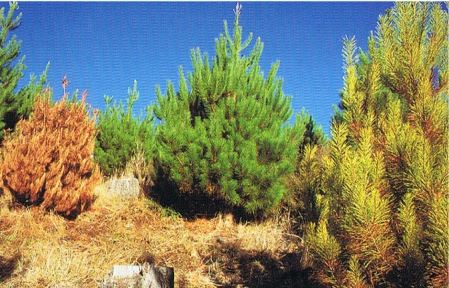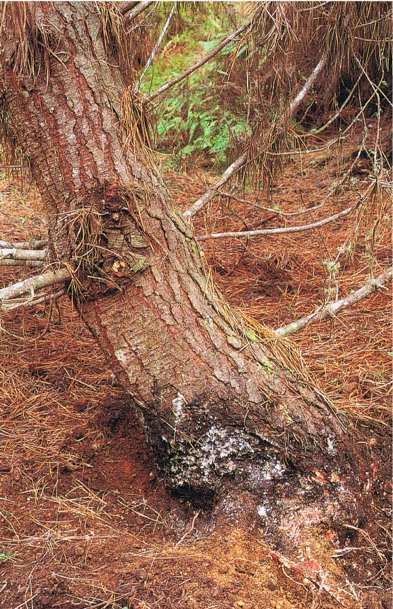PESTS AND DISEASES OF FORESTRY IN NEW ZEALAND
Root rot caused by Armillaria spp.
Scion is the leading provider of forest-related knowledge in New Zealand
Formerly known as the Forest Research Institute, Scion has been a leader in research relating to forest health for over 50 years. The Rotorua-based Crown Research Institute continues to provide science that will protect all forests from damage caused by insect pests, pathogens and weeds. The information presented below arises from these research activities.
From Scion publication Forest Research Bulletin 220, An Introduction to The Diseases of Forest and Amenity Trees in New Zealand,
G.S.Ridley and M.A. Dick 2001.
Species: Armillaria limonea and A. novae-zelandiae (Basidiomycete)
Common name: Armillaria root rot
Country of origin: New Zealand
Host(s): A very wide range, especially among introduced species. Among forest trees, pines are most susceptible, but there is evidence of some attack on eucalypts and Douglas-fir. Also common in kiwifruit and garden ornamentals.
Symptoms: Crown wilt, and yellowing to yellow-browning of foliage, finally turning brick-red and these may remain firmly attached to the dead tree; affected trees are grouped (Fig. 77); resinosis on roots and root collar (Fig. 78), and cankering in older trees; white to brown mycelial sheets present under dead bark and rhizomorphs may be present.
Disease development: Armillaria species occur naturally in native beech and broadleaf/ podocarp forests. The clearfellingand burning of native sites fails to remove Armillaria spp. from the soil where they survive as a wood-decay fungus. When the site is planted for plantation forestry, mortality occurs around the remaining native tree stumps. In such sites infection occurs by rhizomorphs and root contacts.

Fig. 77: Group mortality of young Pinus radiata in a third-rotation non-forested site, caused by Armillaria novae- zelandiae
Wind-borne basidiospores also play a role in augmenting already- infected sites and colonising sites that previously lacked woody vegetation, such as old pasture now planted in trees. Infection occurs in the roots but if the fungus reaches and girdles the root collar, killing the cambium, death of the tree will result. A study of site factors has suggested that Armillaria spp. prefer sites with a mean annual temperature below 13°C, with rainfall between 1000 and 1600 mm per annum, and which have been previously forested. A study at Golden Downs Forest showed a topographical effect with 54% infection in gullies but only 6% on steep slopes. However, if soil moisture levels were high then no topographical effect could be observed.
NZ distribution: Found throughout New Zealand where woody vegetation occurs.

Fig. 78: Pinus radiata tree with a healthy crown infected at the root collar by Armillaria nova-zelandiae
Economic impact: An estimated 50 000 ha of first-rotation P. radiata plantations are affected with Armillaria spp., and in some areas up to 50% of the planting can die within the first 5 years. There is unpublished evidence that there is significant volume loss in first-rotation P. radiata plantations on clearfelled native forest sites, and a lower but still significant volume loss in second-rotation P. radiata plantations on non-forested sites. It is also common in parks and gardens.
Control: Site burning reduced rhizomorphs in the soil from 41-89% to 5-14% but levels soon recovered. Removing and burning stumps reduced mortality at age 5 from 52% to 12-21%; however, this is very expensive and suitable for relatively flat terrain only. Chemical treatment of stumps has had some success but is not economic.
History: Until 1964 all Armillaria spp. in New Zealand were identified as the cosmopolitan A. mellea. Then in 1964 G. Stevenson recognised that in native forest two native species, A. novae-zelandiae and A. limonea, were present and not A. mellea. However, anything collected outside native forest was still identified as A. mellea. In the late 1970s it was suggested that A. mellea did not occur in New Zealand. This was confirmed in the early 1980s when the predominant species in exotic plantations was found to be A. novae-zelandiae. After the first major wave of Pinus radiata planting in the 1930s, significant mortality of young trees caused by Armillaria spp. on native forest cutover sites was noted. By the 1950s it was no longer considered a problem in these maturing plantations. With the second wave of planting in the 1960s significant mortality was again noted. In the first 3-5 years after planting, up to 50% mortality could occur in some sites and it was estimated that some 50 000 ha were affected. Mortality of young trees was centred about native hardwood stumps and it was feared that this would create gaps in the stands, which would encourage weed growth. It was also feared that the gaps might continue to grow, as had been documented in the Pacific Northwest of the United States. However, the only real evidence for the expansion of New Zealand species of Armillaria is from kiwifruit orchards. At the same time it was realised that the host tree was not necessarily killed by the pathogen but could achieve some balance. There was concern that chronic infection could cause incremental growth of older trees to be reduced and make them more prone to windthrow. Such loss in final-crop trees was considered to be more serious than the mortality at establishment. In a 10-year-old pine plantation on the Mamaku Plateau, near Rotorua, 60% of the trees had chronic infections and 15% had more than 65% of their stems girdled by Armillaria spp. It was estimated that this would cause a 29-30% potential volume reduction from growth loss and wind throw. A re-evaluation at age 19 showed that 6% of the remaining trees had died or been blown over and that 53% had chronic infections. However, a third of the trees infected at age 10 were no longer infected. The infection classes of some infected trees had changed — that is, some had heavier infections and some had less infection than at age 10. At this stage it was estimated that Armillaria spp. would cause a 6-13% loss in potential volume at harvest. The trees were finally assessed at age 28. Again, infection classes had changed and no significant correlation could be found between present infection class and the stem diameter at harvest. The general conclusions that can be drawn from this study are that the host/pathogen interaction is dynamic and that Armillaria spp. may have little effect on final harvest. However, this does not negate the high losses that can occur before age 5.
References: Hood 1989; Hood & Sandberg 1993; Pas 1981; Pas et al. 1983; Shaw & Calderon 1977; Stevenson 1964.
This information is intended for general interest only. It is not intended to be a substitute for specific specialist advice on any matter and should not be relied on for that purpose. Scion will not be liable for any direct, indirect, incidental, special, consequential or exemplary damages, loss of profits, or any other intangible losses that result from using the information provided on this site.
(Scion is the trading name of the New Zealand Forest Research Institute Limited.)

 Farm Forestry New Zealand
Farm Forestry New Zealand

